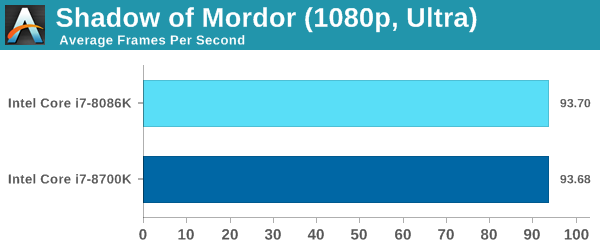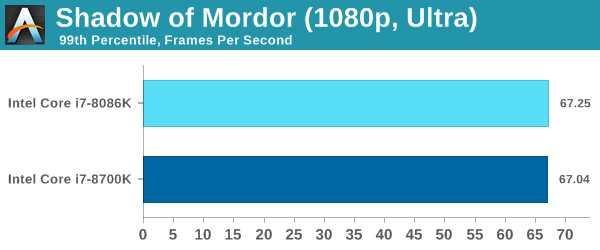The Intel Core i7-8086K Review
by Ian Cutress on June 11, 2018 8:00 AM EST- Posted in
- CPUs
- Intel
- Core i7
- Anniversary
- Coffee Lake
- i7-8086K
- 5 GHz
- 8086K
- 5.0 GHz
Shadow of Mordor
The next title in our testing is a battle of system performance with the open world action-adventure title, Middle Earth: Shadow of Mordor (SoM for short). Produced by Monolith and using the LithTech Jupiter EX engine and numerous detail add-ons, SoM goes for detail and complexity. The main story itself was written by the same writer as Red Dead Redemption, and it received Zero Punctuation’s Game of The Year in 2014.
A 2014 game is fairly old to be testing now, however SoM has a stable code and player base, and can still stress a PC down to the ones and zeroes. At the time, SoM was unique, offering a dynamic screen resolution setting allowing users to render at high resolutions that are then scaled down to the monitor. This form of natural oversampling was designed to let the user experience a truer vision of what the developers wanted, assuming you had the graphics hardware to power it but had a sub-4K monitor.
The title has an in-game benchmark, for which we run with an automated script implement the graphics settings, select the benchmark, and parse the frame-time output which is dumped on the drive. The graphics settings include standard options such as Graphical Quality, Lighting, Mesh, Motion Blur, Shadow Quality, Textures, Vegetation Range, Depth of Field, Transparency and Tessellation. There are standard presets as well.
We run the benchmark at 1080p and a native 4K, using our 4K monitors, at the Ultra preset. Results are averaged across four runs and we report the average frame rate, 99th percentile frame rate, and time under analysis.
All of our benchmark results can also be found in our benchmark engine, Bench.
ASRock RX 580 Performance















111 Comments
View All Comments
ipkh - Monday, June 11, 2018 - link
The multiplier chart doesn't make sense.The single core is 5Ghz, but Intel is quoting 4.7 Ghz all core and you're showing 4.4 identical to 8700K. I understand the base frequencies are the same, but the default multiplier for the 8086K should be higher. Is this a possible bios glitch or is the multiplier chart in the CPU not correct?
Hxx - Monday, June 11, 2018 - link
Boost frequencies are all the same on 5 cores. there is a youtube video with somebody testing this chip on a z370 gaming 7 and you can clearly see in that video that boost is the same on all cores except 1. Intel = lame.Ian Cutress - Monday, June 11, 2018 - link
Where is Intel promoting 4.7 GHz all core?HStewart - Monday, June 11, 2018 - link
One thing that is strange is the name - the Original IBM PC that started this whole PC industry used the intel 8088 processor and not the Intel 8086 processor. The difference is that 8088 has 8 bit external and 8086 has 16 bit external - But CPU's used 16 bit internally. No internal Floating processor until the 386 line.But it wild that it been 40 years - I have an original IBM PC - in my downstairs closet, I remember while at Georgia Tech - putting a 2Meg Ram card into and booting up to 1.4Meg ramdisk and loading Microsoft C 3.0 compiler on it.
As for new one - it would be cool if they actually included the original chip also as part of collectors edition.
AsParallel - Monday, June 11, 2018 - link
8088 shipped in 79, was a variant of the 8086. 8086 was the first to 1M transistorspeevee - Monday, June 11, 2018 - link
"No internal Floating processor until the 386 line."486. 386 still used 387 AFAIR. There were even 487, but it was just renamed 486 to be installed with 486SX.
HStewart - Monday, June 11, 2018 - link
Yes I forgot that - the 486 was the one with Math Coprocessor.AsParallel - Monday, June 11, 2018 - link
Addition. The 8087 was the floating point coprocessor for the 8086/8829a - Monday, June 11, 2018 - link
You didn't put 2mb of RAM in an original IBM PC it supported 256kb max.HStewart - Monday, June 11, 2018 - link
I had a special card in the PC - it was EMS memory - that could also fill up the main system memory to 640kb - instead of normal cache mode use by the card - I configured it as ram drive. Memory above 640Kb was directly accessible by the system.